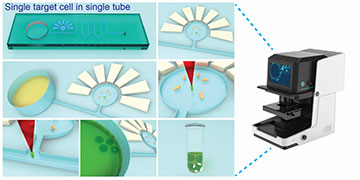Combining the “pool-screening” design and optical tweezer realizes single-cell identification, moving and isolation, resulting in One-Cell-One-Tube. [Image: XU Teng] [Enlarge image]
Single-cell sequencing methods have revolutionized the biomedical sciences by enabling the analysis of individual cells rather than averaging over thousands or even millions of heterogeneous cells. Today’s scientists can tease out differences in cell types and their function for an enhanced understanding of human health and disease.
Now, researchers in China have developed an intelligent, image-activated cell sorter that combines optical tweezers and microfluidics to select target cells for downstream multi-omics profiling (Lab Chip, doi: 10.1039/d2lc00888b). According to the authors, the low-cost device can perform single-cell sorting and isolation with versatility, ease and flexibility.
A better cell-sorting tool
Real-time image-based cell sorting—using either bright field, fluorescence or Raman microspectroscopy—allows biologists to pick and choose cells of interest in a “what you see is what you get” manner. However, current techniques have significant drawbacks that limit their application.
For instance, traditional flow cytometry can handle only low-resolution data for real-time data processing and cell sorting, which leads to inaccurate results. Dielectrophoresis arrays are unable to sort small cells less than 5 µm in diameter, such as bacteria. And the illumination from a method known as laser-induced cell ejection tends to damage large cells.
“Real-time image-based sorting of target cells in a precisely indexed manner is desirable for sequencing or cultivating individual human or microbial cells directly from clinical or environmental samples,” said study author Teng Xu of the Qingdao Institute of Bioenergy and Bioprocess Technology (QIBEBT) of the Chinese Academy of Sciences (CAS). “However, versatility of existing methods is limited as they are usually not broadly applicable to all cell sizes.”
Xu and colleagues aimed to design an easy-to-use, cost-efficient alternative that could work with a broader range of cell sizes, from bacteria of 1 µm to human cells of several dozen micrometers in diameter.
Incorporating optical tweezers
In the end, they created a novel optical tweezer–assisted pool-screening and single-cell isolation (OPSI) system, which they named EasySort. The system features an OPSI microfluidic chip to provide a highly controllable static flow field for cell screening, as well as optical tweezers for precise and low-damage single cell manipulation. Optical tweezers employ radiation pressure from a highly focused laser beam—in this case, a 1064 nm continuous-wave diode-pumped laser—to trap and manipulate small objects.
First, EasySort screens and captures individual live human or bacterial cells in real time via bright-field, fluorescence or Raman imaging. The target cell is moved using the optical tweezer to its own microchannel and packaged in a microdroplet for transport. Finally, the droplets are exported to a test tube with a pipette tip and made ready for multi-omics analysis.
Based on initial experiments on bacterial, yeast and human cells, EasySort can handle cells ranging from 1 to 40 µm in size, achieving more than 99.7% target-cell sorting purity at a speed of 10 to 20 cells per minute, according to the researchers. They believe it offers several advantages over existing cell-sorting systems, such as versatility, a modular design and no apparent photodamage to cells.
“The next steps are the introduction of artificial intelligence-based automatic recognition to this OPSI chip method, along with automatic manipulation steps, to further increase the throughput and greatly broaden the usage of this technology,” said Xu.


